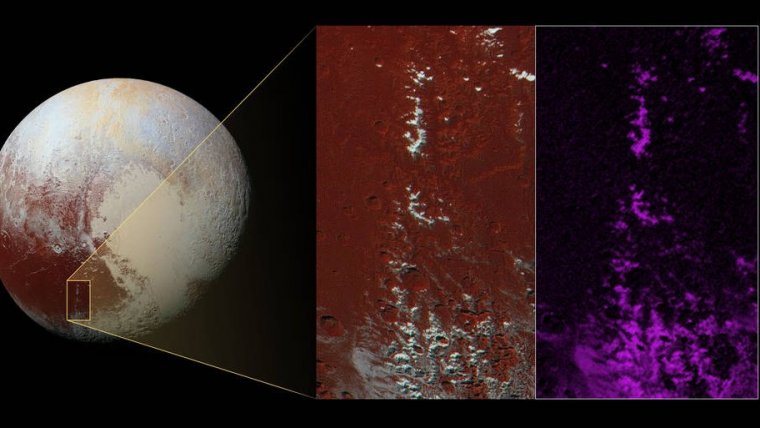| News / Space News |
Methane Snow on Pluto’s Peaks
NASA | MARCH 12, 2016
The New Horizons team has discovered a chain of exotic snowcapped mountains stretching across the dark expanse on Pluto informally named Cthulhu Regio.

Compositional data from the Ralph/Multispectral Visible Imaging Camera on NASA’s New Horizons spacecraft, shown in the right inset, indicates that the location of the bright ice on the mountain peaks correlates almost exactly with the distribution of methane ice, shown in false color as purple. ![]()
One of Pluto’s most identifiable features, Cthulhu stretches nearly halfway around Pluto’s equator, starting from the west of the great nitrogen ice plains known as Sputnik Planum.
Cthulhu’s appearance is characterized by a dark surface, which scientists think is due to being covered by a layer of dark tholins – complex molecules that form when methane is exposed to sunlight. Cthulhu’s geology exhibits a wide variety of landscapes—from mountainous to smooth, and to heavily cratered and fractured.
The reddish enhanced color image shown as the left inset reveals a mountain range located in southeast Cthulhu that’s 260 miles (420 kilometers) long. The range is situated among craters, with narrow valleys separating its peaks. The upper slopes of the highest peaks are coated with a bright material that contrasts sharply with the dark red color of the surrounding plains.
Scientists think this bright material could be predominantly methane that has condensed as ice onto the peaks from Pluto's atmosphere, like water in Earth's atmosphere, condensing as frost at high altitude.
YOU MAY ALSO LIKE

